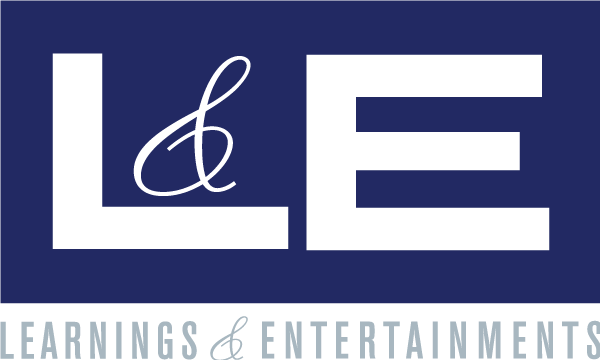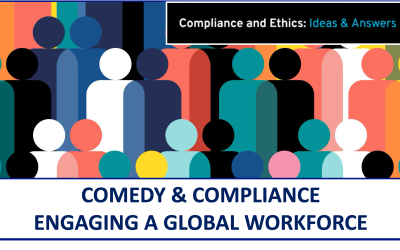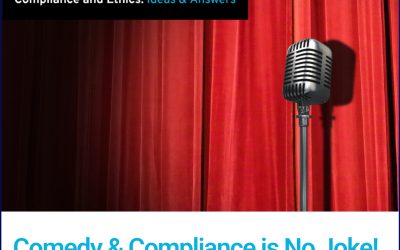
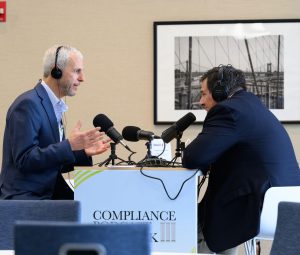
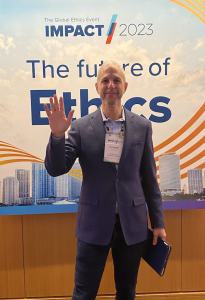
ETHICS & COMPLIANCE SPRING CONFERENCE OBSERVATIONS
We just finished up spring ethics and compliance season! I very much enjoy attending these events and hobnobbing with the community – visiting with clients who appreciate and validate the creative work we do for them; meeting new folks and watching their eyes light up when they hear about “comedians who do compliance”; and of course, listening to what the community is talking about. Having said that, I found this years events to be a bit puzzling. Here are some of my observations.
- Lots of talk about Artificial Intelligence and technology and its potential impact…but without any concrete information about what to do with it or about it.
- Lots of talk about ESG and how ethics and compliance professionals should be involved and/or taking the lead…but also with very few actionable steps.
- Lots of talk about data and measurement, documenting and tracking.
- Lots of talk about risk assessments and emerging risks.
- Lots of patting ourselves on the back with how good a job we’re doing in this challenging environment. (I mostly agree, but still not very helpful.)
VERY FEW SESSIONS FOCUSED ON THE MOST IMPORTANT THING…HOW TO IMPACT BEHAVIORS!
It’s like we’re all distracted by the new shiny object (AI, ESG, etc.) or we’re focused on looking backwards, i.e. how to show the regulators that even though a bunch of bad stuff happened, we can share a bunch of stats that showed that we tried. But are we really trying!?! Are we actually trying to solve the problem? Are we actually trying to make the workplace better? Are we actually trying to impact behaviors so that we can lessen the likelihood that these problems will occur in the first place? Based on the agendas and hallway conversations, I’m not quite so sure we’re putting our focus where it should be.
CALL TO ACTION – LET’S FOCUS ON HELPING PREVENT PROBLEMS BEFORE THEY OCCUR!
We all know that the environment has a huge impact on behavior. All the behavioral science says so. Having knowledge, i.e. learning something, is only part of the equation. Despite this, most programs are still pushing out long, boring, bloated training and they do this because its trackable and measurable and easier for us as E&C professionals (not better for them). We justify this approach because we can show the regulators that employees were informed. But this approach doesn’t help them learn. It doesn’t impact behavior or mitigate risk. I would argue that it exacerbates it.
Even the DOJ has come out and said that E&C programs should be putting more focus on communication and culture. And yet the vast majority of time and resources are spent on things that not only do not impact the culture, they often negatively impact the culture. We bore and annoy our employees who feel like we are wasting their time. The way that we write and promote our policies, train and talk about risks…it seeds the idea that the issues are not important and that we are just pushing liability onto them. That’s how they feel. The words “ethics” and “compliance” have become toxic words in most organizations and our activities are constantly eroding our influence. People do not speak up to ask questions and report concerns when they are bored, annoyed or afraid.
PROACTIVELY IMPACTING THE CULTURE
If we want to orient our programs to influence the culture, to make it simpler and easier for employees to stay within the boundaries of the rules, and be the best versions or themselves, we should focus on two main things – influencing the social environment and influencing leadership.
1. THE SOCIAL ENVIRONMENT: We need group-think to work for us and not against us. When someone does or discusses the possibility of doing something improper, we want our peers to say, “hey, that’s not the way we do things here” as opposed to ignoring the problem or saying, “yeah, do what you need to do, all they care about is making that money.” To impact the social environment, we need to take a hard look at how our programs are training and communicating.
- Reputation, Branding, Positioning: Be honest about the reputation of your program. If it still has the image of being the finger-waggy “office of no” then you can start by changing the brand. Take a look at the programs name, logo, acronym, mascot, etc. Does it reflect the helpful, welcoming, approachable resource that you are…or hope to be? Marketing 101 – if you have a bad brand, change it! Give the program a makeover.
- Psychological Safety and Speak Up Culture: Everyone thinks they have integrity, so all that training, they just tune out. We need enough people to feel safe and secure enough to speak up and call out bad behavior, and we know that because of the social stigma, the default for the majority is that they will not. This is why we should be constantly promoting the support system of people, policies and resources as often as possible. We need to continuously inform employees that there will be accountability and organizational justice when things go wrong. We need to create an environment of psychological safety. We can’t do this with a once-a-year speak up campaign or a once a year Compliance Week or an annual or even quarterly training. Think of it as ethics & compliance PR. We have to find ways to integrate, embed and spread the message in as many places as possible, as often as possible.
-
- Train Less, Communicate More – People need reminding more than instruction. Reduce training seat time. It’s largely ineffective anyway. If you feel the need to capture completion rates, treat it like the check-the-box activity that it is. Get that training done as quickly and efficiently as possible, and then spend your time and resources on things that actually help people. Increase the frequency of speak up campaign and promoting the support system. Embed those messages in more places, like commercials. We need this positive E&C PR to be the tide that continually washes over people.
- Simplify and Improve Ease of Access To Information – Keep messaging short, simple and interesting/provocative. We don’t need employees to know every nuance of the rules. We want employees to issue-spot and then ask for help. Again, treating your communications like commercials is helpful because you can then put those messages in more places. You can use these commercials to highlight and drive traffic to the support system: policies, learning resources, E&C office, the Helpline, etc.
- Entertainment & Creativity is Helpful – If you want to increase the visibility and approachability of the support system without message fatigue, you need to get creative. This doesn’t necessarily mean funny. It does mean that while you should have consistency of messaging, you should vary the delivery mechanism/wrapper in which those messages are contained. Be interesting. Be entertaining. Be creative. Communicate colorfully to help rise above the noise and stand out.
-
- Be Helpful Advisors & Coaches – Yes-And: It goes without saying (although I’m saying it) that if we want to position our program as the helpful, welcoming advisors and coaches that we are…we have to walk the walk. That means giving our E&C team soft-skills training so that we are better communicators and collaborators. That means, rewriting our policies, trainings, newsletters, policy portals so that they reflect a more helpful, less judgmental tone. It means being a contributor and collaborator that is a value-add to help the business solve problems within the rules. E&C’s reputation will change, but it will take time.
2. THE LEADERSHIP ENVIRONMENT: The other major influence of behavior is leadership. (see the famous Stanley Milgram experiment) Leadership has a huge impact on behavior…and leaderships impact is local. Your company may have a great corporate culture but if your immediate boss is problematic, your culture is bunk. We need to influence leadership at all levels. All the work you do to promote psychological safety and speak up culture goes down the drain with a look-the-other-way-leader, a fear-intimidation-leader or a lip-service-leader who promotes ethics and compliance with an eye-roll. We need them on our side.
- Train Leaders: If I had a dollar to spend, I would start spending it here. You certainly need senior leadership on board. If at the very top they don’t actually believe in doing business the right way, your program is already in trouble. So we need to spend time training senior leadership, middle management and the front-line mangers on the additional ethical responsibilities of leadership. Make sure they know about and share the tools and resources available. Make sure they spend time sharing difficulties navigating ethical dilemmas, so employees know that not just winning business but winning business the right way. Make sure they create space to listen to employees concerns and are serious about confidentiality. And make sure they know that they are supported so they are comfortable seeking out advice and support.
-
- Training & Communications – Ideally these additional learning opportunities should be coordinated in parallel with training, communications and events that leaders are already going through. New hire manager training, high potential programs and other regular leadership meetings & events. Ethical leadership is not an additional thing they have to do. It’s a part of the regular leadership training, communications and events that they are already a part of. It’s foundational messaging that becomes part of a leaders DNA.
- Commercials – People need reminding more than instruction. So just like the suggested techniques listed above, short, frequent commercials integrated into leaders weekly/monthly routines is helpful.
-
- Involve Leaders: To really solidify leadership influence we need to involve them, which makes it more likely that they will carry the integrity and speak up messaging forward on your behalf.
-
- Meeting-in-a-box – Pre-package short, simple micro-learning (a video with talking points/facilitators guide) that makes it simple and easy for leaders to share and discuss important messaging in 15-minutes at the local level.
- Commercials – Give short videos to leaders and have them play 90-second integrity and speak up videos as part of regular department meetings…every month.
- Entertainment & Creativity is Helpful – If you make these communications and trainings short and fun, it increases the likelihood that leaders will integrate, embed and spread these messages on a more regular basis. Improv principal #1, make your partners look good.
-
I’m not saying that AI and Chat-GPT won’t have an impact. I’m not saying that ESG isn’t important. I’m not saying that measurement isn’t important. I am saying that as a community, we should keep our eye on the ball. To me that means focusing the majority of our attention, time and resources on helping people be the best versions of themselves. Making it simpler and easier for them to stay within the boundaries of the rules and to do the right thing, even when no one is watching. As the Fall conferences come around, I hope we’ll start to see more focus on how the E&C community can proactively influence behaviors and corporate culture.
Ronnie Feldman is the President & Creative Director at Learnings & Entertainments, a learning content provider made up of comedians and entertainers with a focus on corporate risk. www.LearningsEntertainments.com
